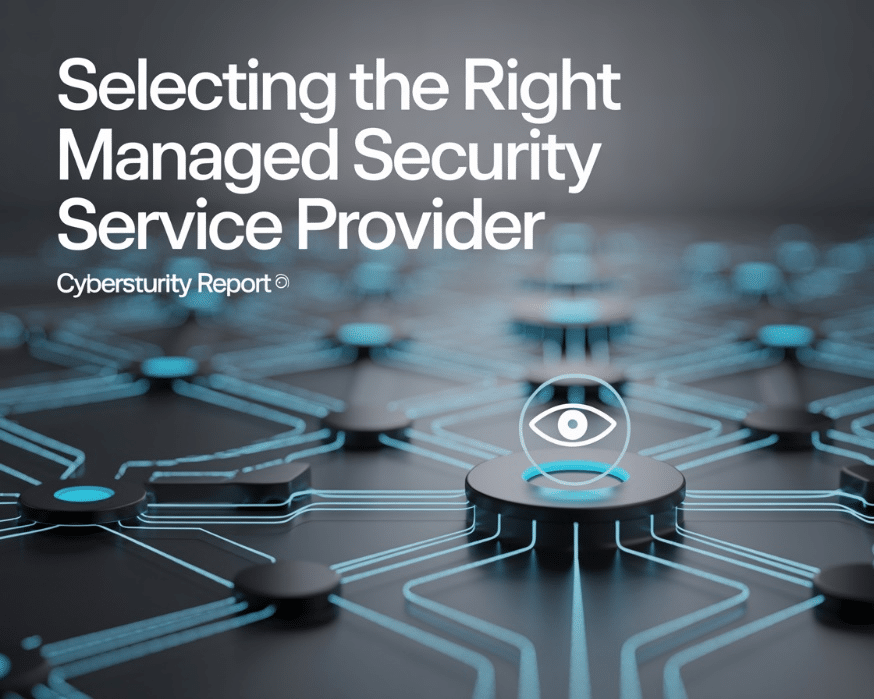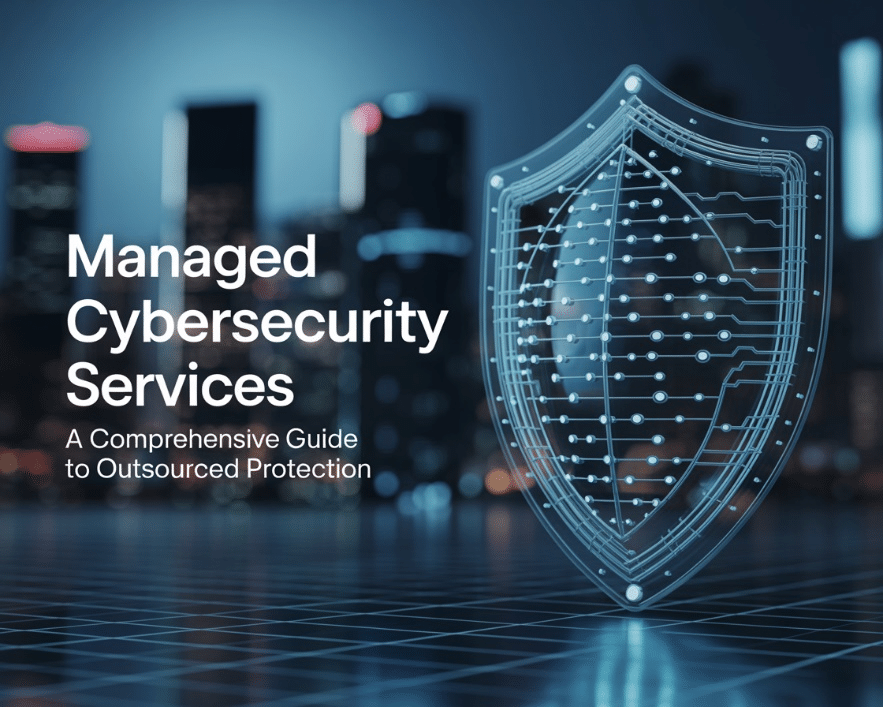The cybersecurity environment keeps on changing, and threats are becoming more frequent and more sophisticated. For instance, according to the recent reports, 68% of business leaders think that their cybersecurity risks are elevating, while 77% of organizations expect to increase their budgets for the coming year. Despite such investments, most businesses find that they do not have adequate internal resources and expertise, making it difficult to maintain adequate protection.
Managed cybersecurity services offer a solution. Outsourcing specific security features from specialized providers allows businesses to gain top-notch expert protection without the burden of building and maintaining in-house security teams. This is an all-you-need-to-know comprehensive guide to managed security services and how they can strengthen your business defenses.
What Are Managed Cybersecurity Services?
Managed cyber security services are facilitated through provided third-party managed security service providers. It manages an organization’s operations entirely and specializes from monitoring networks on suspicious activity up to handling the complete security infrastructure of an organization.
Contrary to the typical security approaches where businesses would purchase security tools and operate them in-house, managed services are provided on a subscription. The business pays some fees regularly (usually monthly) for security, expertise, and assistance on a continuing basis.
Most managed security services are offered under the three delivery models:
- Co-managed security: Your internal staff assumes a collaborative infrastructure with the service provider in sharing responsibilities.
- Fully managed security: In this case, all the roles concerning a specified security function are the sole responsibility of the provider.
- Cloud-based security: Security tools and monitoring are provided over cloud platforms in order to minimize on-premise infrastructure requirements.
The best action to take depends on your particular needs, capabilities, and security aims. Awareness of the options available to you with respect to comprehensive security services will aid you in making informed decisions that are aligned with the long-term strategy of your organization.
Benefits of Outsourcing Your Cybersecurity
Managed security services would have become a hot cake for many businesses for many irresistible reasons:
24/7 Protection
The threat of cyber-attack does not occur at even set times. Round-the-clock monitoring and arrest response features are too expensive usually for most businesses to maintain within their organization.
Access to Security Experts
There is quite a shortage of professionals in cybersecurity who have the requisite skills. MSSPs usually hire a number of specialists who specialize in various areas just to avail talent which is otherwise quite hard to source, recruit, and retain.
Cost Predictability
An expensive undertaking, setting up an internal security operations center can cost millions of dollars in technology, personnel and training. Managed services thereby convert these capital expenditures for predictable operational costs.
Advanced Technology
In case you’re wondering, yes, all security providers are investing in technologies that are high-tech in detection and prevention, to which most businesses would never have access. The sophistication of their specialization spans more than one vendor solution.
Faster Threat Response
Usually, MSSPs will help in review and response to the threat within a couple of minutes instead of days. Such a quick response makes a drastic reduction in the effect a security incident has.
Scalability
Managed services can scale with your business to include new systems, locations, or business units as your security needs will change with the growth of your business.
With all these points offered as an advantage, organizations looking at their security strategy understand very well that through these points, informed decisions could be made of which security functions they would keep in-house and which ones outsourced.
Core Managed Security Service Categories
Managed security services connect various types of services. Below are the most common categories:
Managed Detection and Response (MDR)
This service focuses on identifying threats that would have passed through any preventive measures already in place. Monitoring potential threats, the MDR service provider actively correlates and analyzes suspicious activity on your behalf. All in all, we consider MDR to be security analysts looking at your systems 24/7.
Security Operations Center (SOC) as a Service
The virtual SOC provides real-time security monitoring, threat detection, and incident response. It basically gives you an entire team of security response personnel without the overhead of actually having to build an in-house SOC.
Managed Firewall and Network Security
The provider will configure, install, and monitor firewalls and other network security products to manage traffic and prevent unauthorized access. This service ensures that the outer layer of your network is protected against external threats.
Vulnerability Management
Frequent scanning and assessment of your systems for security weaknesses that hackers might exploit. Vendors will prioritize the vulnerabilities according to risk and propose remediation guidance.
Identity and Access Management
Management of user authentication, authorization, and privilege to ensure that only the right entities may access sensitive resources. Such services are becoming increasingly important with the rise of remote working models for organizations.
Cloud Security Monitoring
It includes specialized protection for cloud environments, covering configuration management, access control, and threat detection across various cloud platforms.
How to Determine If Managed Services Are Right for Your Business
Not every security function needs to be outsourced; here are a few things to consider regarding evaluating managed services:
- Assessment of Internal Capabilities: Take a look at the skills, capacity, and expertise of your existing security team. Where are the gaps? Which functions strain your current resources?
- Security Maturity: Organizations that have less developed security programs generally benefit from managed services more than organizations with mature security teams who might choose to completely outsource only highly specialized functions.
- Budget Realities: Compare the costs of in-house capabilities building with outsourcing including an all-encompassing comparison for personnel, training, technology, and operations.
- Compliance Requirements: The industries usually having strict regulatory requirements tend to benefit much from managed services specializing in compliance frameworks such as HIPAA, PCI DSS, or GDPR.
- Business Criticality: Outsource as much of the security functions as necessary, but only for your most critical systems.
Most have found that the hybrid model works best. Maintain all strategic functions in-house while outsourcing the operational tasks to managed services requiring 24/7 attention.
Selecting the Right Managed Security Service Provider

The effectiveness of managed security services depends largely on choosing the right provider. Evaluate potential partners using these criteria:
- Industry Experience: Look for providers with specific experience in your industry who understand your unique security challenges and compliance requirements.
- Technical Expertise: Assess their team’s certifications, experience with relevant technologies, and threat intelligence capabilities.
- Service Level Agreements: Review response time guarantees, remediation protocols, and accountability measures for security incidents.
- Technology Stack: Evaluate the security technologies they use. The best providers leverage multiple best-in-class tools rather than relying on a single vendor.
- Transparency and Reporting: Look for clear, actionable reporting that helps you understand your security posture and incident trends.
- Cultural Fit: Your security provider becomes an extension of your team. Ensure their communication style and approach align with your organization’s culture.
For a detailed comparison of service providers in the market, check out our analysis of security service options and provider selection criteria.
Implementation and Integration Best Practices
The cornerstone of a successful managed security services integration is the definition of roles and responsibilities. Not only should your internal staff understand their role, but so should the managed security service provider. Implementing the engagement in phases will reduce disruption, giving time for adjustments and smooth adoption.
Knowledge transfer is vital. Your personnel must know how to interact with the managed services and interpret security data. Security policies should be aligned with those recommended by the provider to ensure consistency in access controls and compliance. Furthermore, incident response procedures should be created with a clear line of communication and escalation pathway.
A thorough integration creates a unified security ecosystem, which enhances protection while not interrupting corporate continuity.
Measuring the Value of Managed Security Services
To assess the performance of managed security services, measure how much value they add to your business through their critical metrics. One is the measure of effective threat detection and covers the number and types of threats identified, especially those that were previously unidentified. Increased response time improvement shows the speed at which contained threats were compared to what it was before for less potential damage.
Security incident mitigation assessment records how managed services really reduce the number and severity of attacks. Also, achieving compliance is essential in ensuring that your company falls under the purview of the various regulatory bodies and resource efficiency is how much time your internal team saves because of security outsourcing.
Performance metrics should thus be monitored by regular performance reviews with the provider in order to ensure that continuous improvement is achieved against one’s security goals.
Common Challenges and How to Overcome Them
Working with a managed security service provider can come with challenges, even for a company that has a strong security strategy in place. These challenges are brought about by some organizations losing visibility, facing communication gaps, and integration problems, among others. Addressing these concerns early makes for a smoother partner relationship and cost efficiency in managing security.
- Visibility Gaps – Regular, detailed reporting and general dashboard access help ensure that security operations run transparently.
- Communication Problems – Clear channels of communication and escalation protocols work wonders to prevent misinterpretations and misunderstandings.
- Integration Problems – Confirm compatibility with your existing technology stack before you sign any contracts.
- Gaps in Security Controls – Regular coverage review to make sure you will not miss any security functions that are critical.
- Alert Fatigue – Fine-tune these detection mechanisms for a well rounded security monitoring without increasing the number of false alerts.
By managing proactively those events, businesses vastly increase the benefit of the security services they manage when using managed service providers and further increase the overall security posture and efficiency.
Protecting Your Business Through Strategic Partnerships
Managed security service essentially means a strong partnership for the real-time enhancement of your security capabilities. By bringing in expert resources, technologies, and round-the-clock support, businesses of any size can achieve difficult-to-establish security postures.
Ultimately, the key is to find a balanced combination of outsourced security and in-house resources that fits your needs, skills, and risk tolerance. Perform a thorough assessment of your existing gaps in security, check the various potential providers, and start the delivery of services against measurable success criteria.
In today’s evolving threat business environment, the choice of partnership for security is no longer a technical decision but rather a business decision. Is your strategy strong enough to fight against modern threats? Get working on this today by evaluating your security infrastructure and ensuring that your business is future-proofed.

